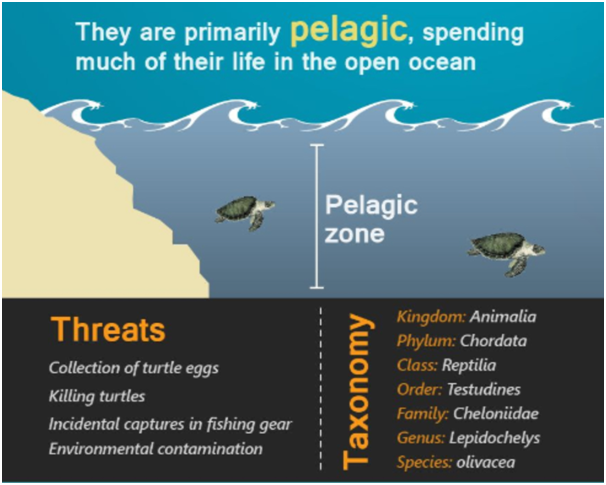Olive Ridley sea turtles
Context: Recently the mass nesting of Olive Ridley sea turtles, an annual phenomenon called ‘arribada’, began in Odisha’s Gahirmatha Marine Sanctuary. As many as 503,719 turtles laid eggs in the last four days on the tranquil beaches of the sanctuary in Kendrapara district, the world’s largest rookery of sea turtles.
More on the news
- The Olive ridley turtles are the smallest and most abundant of all sea turtles found in the world, inhabiting warm waters of the Pacific, Atlantic and Indian oceans.
- These turtles, along with their cousin the Kemps ridley turtle, are best known for their unique mass nesting called Arribada, where thousands of females come together on the same beach to lay eggs.
- Arribada, which is the Spanish word for the phenomenon, continues for roughly a week and the eggs hatch in around 45 days
- Though found in abundance, their numbers have been declining over the past few years, and the species is recognized as Vulnerable by the IUCN Red list.
- They are carnivores, and feed mainly on jellyfish, shrimp, snails, crabs, molluscs and a variety of fish and their eggs.
- The coast of Orissa in India is the largest mass nesting site for the Olive-ridley, followed by the coasts of Mexico and Costa Rica.
Threat and Protection Measures
- Olive-ridleys face serious threats across their migratory route, habitat and nesting beaches, due to human activities, development and exploitation of nesting beaches for ports, and tourist centres.
- Though international trade in these turtles and their products is banned under CITES Appendix I, they are still extensively poached for their meat, shell and leather, and their eggs.
- However, the most severe threat they face is the accidental killing of adult turtles through entanglement in trawl nets and gill nets due to uncontrolled fishing during their mating season around nesting beaches.
- To reduce accidental killing in India, the Orissa government has made it mandatory for trawls to use Turtle Excluder Devices (TEDs).
- A net specially designed with an exit cover which allows the turtles to escape while retaining the catch.
| Horseshoe crabs disappearing off Odisha’s coast
● Horseshoe crabs, one of the oldest living creatures on earth and medicinally priceless, appear to be disappearing from their familiar spawning grounds along Chandipur and Balaramgadi coast in Odisha’s Balasore district. ● Scientists have urged the Odisha government to come up with a robust protection mechanism before the living fossil becomes extinct due to destructive fishing practices. ● Like olive ridley sea turtles, these crabs are basically deep-sea animals. They come to the coasts of Balasore in Odisha and Digha and Sundarban in West Bengal for breeding purposes. They select a suitable site for laying their eggs. Medicinal value ● The blood of this crab is very important for the preparation of rapid diagnostic reagents. All injectable medicines are tested on them. ● A molecule has been developed from a reagent of horseshoe crab to help treat pre-eclampsia. ● This is the oldest living creature on earth. Palaeontological studies say the age of horseshoe crabs is 450 million years. ● The creature has lived on earth without undergoing any morphological change. |
| Practice Question
1. Sustainable fishing is the only option for an ecological resurgence. Elaborate |





